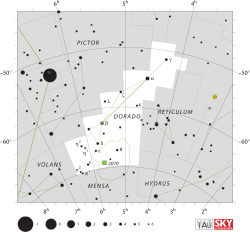Alpha Doradus

| ||
| Observation data Epoch J2000.0 Equinox J2000.0 (ICRS) | ||
| Constellation | Dorado | |
| Component | A | B |
| Right ascension | 04h 33m | 04h 33m |
| 59.778s | 59.782s | |
| Declination | −55° 02′[1] | −55° 02′[2] |
| 41.91″ | 42.39″ | |
| Apparent magnitude (V) | 3.8[3] | 4.3[3] |
| Characteristics | ||
| Spectral type | A0IIIp[3] | B9IV[3] |
| U-B color index | −0.35[3] | |
| B-V color index | −0.10[3] | |
| R-I color index | −0.09[3] | |
| Variable type | ACV[4] | |
| Astrometry | ||
| Radial velocity (Rv) | 25.6 ± 0.9[5] km/s | |
| Proper motion: | ||
| RA (μα cos δ) | 58.06[1] mas/yr | 42.83[2] mas/yr |
| Dec. (μδ) | 12.73[1] mas/yr | 12.94[2] mas/yr |
| Parallax (π) | 19.34 ± 0.31[6] mas | |
| Distance | 169 ± 3 ly (51.7 ± 0.8 pc) | |
| Details | ||
| Mass | 3.33 ± 0.10[7] M☉ | 2.7[8] M☉ |
| Radius | 3.5 ± 0.3[7] R☉ | 1.9[8] R☉ |
| Surface gravity (log g) | 4.02 ± 0.07[7] | |
| Luminosity (bolometric) | 195[7] L☉ | 70[8] L☉ |
| Temperature | 11,588[7] K | 12,200[8] K |
| Rotation | 2.94 days[7] | |
| Orbit[9] | ||
| Period (P) | 12.1 y | |
| Semimajor axis (a) | 0.18″ | |
| Eccentricity (e) | 0.80 | |
| Inclination (i) | 31° | |
| Longitude of node (Ω) | 140° | |
| Periastron epoch (T) | B1986 | |
| Argument of periastron (ω) (secondary) | 193° | |
| Database references | ||
| SIMBAD | data | |
| Other designations | ||
Alpha Doradus (Alpha Dor, α Doradus, α Dor) is the brightest star in the southern constellation of Dorado. The distance to this system, as measured using the parallax method, is about 169 light-years (52 parsecs).[6]
This is a binary star system[8] with an overall apparent visual magnitude that varies between 3.26 and 3.30,[4] making this one of the brightest binary stars.[10] The system consists of a subgiant star of spectral type B revolving around a giant star with spectral type A in an eccentric orbit with a period of about 12 years.[3][9] The orbital separation varies from 2 astronomical units at periastron to 17.5 astronomical units at apastron. The primary, α Doradus A, is a chemically peculiar star whose atmosphere displays an abnormally high abundance of silicon, making this an Si star.[7]
Alpha Doradus has an optical companion, CCDM J04340-5503C, located 77 arcseconds away along a position angle of 94°. It has no physical relation to the other two stars.[3][11]
References
- ↑ 1.0 1.1 1.2 HIP 21281, record for component 1, Hipparcos catalogue; CDS ID I/239.
- ↑ 2.0 2.1 2.2 HIP 21281, record for component 2, Hipparcos catalogue; CDS ID I/239.
- ↑ 3.0 3.1 3.2 3.3 3.4 3.5 3.6 3.7 3.8 HR 1465, database entry, The Bright Star Catalogue, 5th Revised Ed. (Preliminary Version), D. Hoffleit and W. H. Warren, Jr., CDS ID V/50. Accessed on line September 3, 2008.
- ↑ 4.0 4.1 alf Dor, database entry, The combined table of GCVS Vols I-III and NL 67-78 with improved coordinates, General Catalogue of Variable Stars, Sternberg Astronomical Institute, Moscow, Russia. Accessed on line September 3, 2008.
- ↑ 5.0 5.1 V* alf Dor -- Variable Star, database entry, SIMBAD. Accessed on line September 3, 2008.
- ↑ 6.0 6.1 van Leeuwen, F. (November 2007). "Validation of the new Hipparcos reduction". Astronomy and Astrophysics 474 (2): 653–664. arXiv:0708.1752. Bibcode:2007A&A...474..653V. doi:10.1051/0004-6361:20078357.
- ↑ 7.0 7.1 7.2 7.3 7.4 7.5 7.6 North, P. (June 1998), "Do SI stars undergo any rotational braking?", Astronomy and Astrophysics 334: 181–187, arXiv:astro-ph/9802286, Bibcode:1998A&A...334..181N
- ↑ 8.0 8.1 8.2 8.3 8.4 Kaler, James B., Alpha Dor, retrieved 2012-03-04
- ↑ 9.0 9.1 "Entry 04340-5503", Sixth Catalog of Orbits of Visual Binary Stars (United States Naval Observatory), retrieved 2008-09-03
- ↑ Heintz, W. D. (April 1984), "Note on the orbit of alpha Doradus", The Observatory 104: 88–89, Bibcode:1984Obs...104...88H
- ↑ "Entry 04340-5503, discoverer code HJ3668, components AB-C", The Washington Double Star Catalog (United States Naval Observatory), retrieved 2008-09-03
| ||||||||||||||||||||||||||||||||||